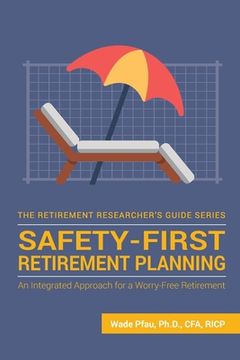Safety-First Retirement Planning: An Integrated Approach for a Worry-Free Retirement: 3 (The Retirement Researcher Guide Series) (in English)
Synopsis "Safety-First Retirement Planning: An Integrated Approach for a Worry-Free Retirement: 3 (The Retirement Researcher Guide Series) (in English)"
Two fundamentally different philosophies for retirement income planning, which I call probability-based and safety-first, diverge on the critical issue of where a retirement plan is best served: in the risk/reward trade-offs of a diversified and aggressive investment portfolio that relies primarily on the stock market, or in the contractual protections of insurance products that integrate the power of risk pooling and actuarial science alongside investments. The probability-based approach is generally better understood by the public. It advocates using an aggressive investment portfolio with a large allocation to stocks to meet retirement goals. My earlier book How Much Can I Spend in Retirement? A Guide to Investment-Based Retirement Strategies provides an extensive investigation of probability-based approaches. But this investments-only attitude is not the optimal way to build a retirement income plan. There are pitfalls in retirement that we are less familiar with during the accumulation years. The nature of risk changes. Longevity risk is the possibility of living longer than planned, which could mean not having resources to maintain the retiree's standard of living. And once retirement distributions begin, market downturns in the early years can disproportionately harm retirement sustainability. This is sequence-of-returns risk, and it acts to amplify the impacts of market volatility in retirement. Traditional wealth management is not equipped to handle these new risks in a fulfilling way. More assets are required to cover spending goals over a possibly costly retirement triggered by a long life and poor market returns. And yet, there is no assurance that assets will be sufficient. For retirees who are worried about outliving their wealth, probability-based strategies can become excessively conservative and stressful. This book focuses on the other option: safety-first retirement planning. Safety-first advocates support a more bifurcated approach to building retirement income plans that integrates insurance with investments, providing lifetime income protections to cover spending. With risk pooling through insurance, retirees effectively pay an insurance premium that will provide a benefit to support spending in otherwise costly retirements that could deplete an unprotected investment portfolio. Insurance companies can pool sequence and longevity risks across a large base of retirees, much like a traditional defined-benefit company pension plan or Social Security, allowing for retirement spending that is more closely aligned with averages. When bonds are replaced with insurance-based risk pooling assets, retirees can improve the odds of meeting their spending goals while also supporting more legacy at the end of life, especially in the event of a longer-than-average retirement. We walk through this thought process and logic in steps, investigating three basic ways to fund a retirement spending goal: with bonds, with a diversified investment portfolio, and with risk pooling through annuities and life insurance. We consider the potential role for different types of annuities including simple income annuities, variable annuities, and fixed index annuities. I explain how different annuities work and how readers can evaluate them. We also examine the potential for whole life insurance to contribute to a retirement income plan. When we properly consider the range of risks introduced after retirement, I conclude that the integrated strategies preferred by safety-first advocates support more efficient retirement outcomes. Safety-first retirement planning helps to meet financial goals with less worry. This book explains how to evaluate different insurance options and implement these solutions into an integrated retirement plan.

